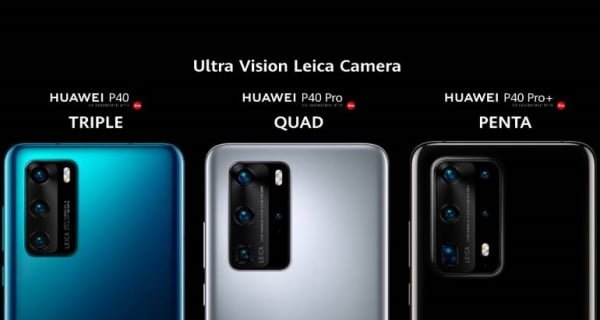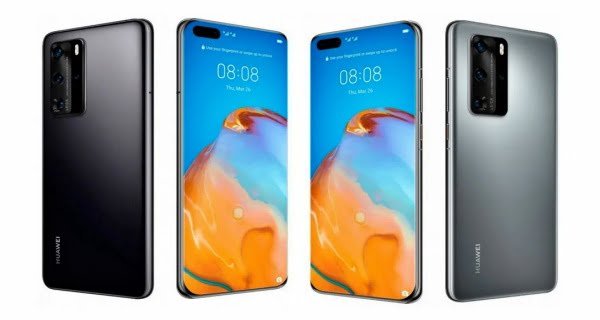
Huawei has unveiled the Huawei P40 series phones as the latest addition to its premium P-series. The series that includes the vanilla Huawei P40, the Huawei P40 Pro, and the Huawei P40 Pro+ that succeeds the Huawei P30 phones, launched in March 2019. The vanilla P40 comes with triple rear cameras while the Huawei P40 Pro packs quad rear cameras. The premium Huawei P40 Pro+ packs five rear cameras and large 6.58-inch display. All the phones come with dual rear cameras and are available to purchase in China. The company is yet to announce details about the phones’ global availability.
Price:
The vanilla Huawei P40 comes in three storage options and five colour variants of Bright Black, Dark Blue, Dawn Jin, Zero White and Frost Silver. Its price starts at CNY 4,188 (approx Rs. 46,200) for the base 6GB + 128GB model while the 8GB + 128GB option costs CNY 4,488 (approx Rs. 49,500 ) and CNY 4,988 (approx Rs. 55,000) for the 8GB + 256GB storage variant. The Huawei P40 Pro’s colour options are the same as the Huwaei P40, and all the models pack 8GB of RAM. The 128GB, 256GB, and 512GB storage options of the smartphone come with a price tag of CNY 5,988 (approx Rs. 66,000), CNY 6,488 (approx Rs. 64,800), and CNY 7,388 (approx Rs. 81,503), respectively. The Huawei P40 Pro+, on the other hand, has only two colour options and are priced at CNY 7,988 (approx Rs. 88,100) for the 8GB + 256GB model and CNY 8,888 (approx Rs. 98,000) for the premium 8GB + 512GB option. All the phones are up for sale in China via Huawei’s official channel Vmall.
Specification:
Starting with the vanilla Huawei P40, the phone sports a 6.1-inch full-HD+ (1,080×2,340 pixels) OLED display and runs Android 10-based EMUI 10.1. As expected, the phone ships with Huawei’s App Gallery and does not include Google services. Under the hood, it packs the octa-core Kirin 990 SoC paired with up 8GB RAM and 256GB storage. Its rear camera setup includes a 50 -megapixel main camera with f/1.9 aperture and 3x optical zoom, a 16-megapixel wide-angle camera with f/2.2 aperture, and an 8-megapixel telephoto camera with f/2.4 aperture and OIS support. The rear camera also supports Artificial Image Stabilization (AIS). At the front, there’s a 32-megapixel camera and an infrared camera for selfies. The phone comes with a 3,800mAh that supports 25W fast charging. Other features on the Huawei P40 include dual-band Wi-Fi, Bluetooth v5.1, OTG, USB Type-C, NFC, 5G/4G, and an in-display fingerprint sensor. The phone supports dual-SIM (nano) and weighs 175 grams.

The Huawei P40 Pro looks identical to the vanilla P40, and it comes with a 6.58-inch full-HD+ (1,200×2,640 pixels) OLED display with 90Hz refresh rate. It runs Android 10 with EMUI 10.1 on top out-of-the-box and includes the same octa-core Kirin 990 SoC with up to 8GB RAM and 512GB storage. However, it comes with a quad rear camera setup that includes a 50-megapixel camera with f/1.9 aperture and OIS support, a 40-megapixel super-wide camera with f/1.8 aperture, a 12-megapixel camera with f/3.4 aperture, and a 3D deep-sensing camera. The rear cameras offer 5x optical zoom and 4K video recording as well as several shooting modes and filters. The front camera setup housed inside the pill-shaped cutout includes a 32-megapixel camera and ToF sensor. It packs a larger 4,200mAh battery that supports 40W fast charging and 27W wireless charging. Its connectivity options are the same as Huawei P40, and it weighs 209 grams.
The display and under-the-hood specifications on the Huawei P40 Pro+ are similar to that of Huawei P40 Pro, and it comes with IP68 rating for dust and water resistance. The main difference that sets the phone apart from the other models lies with the camera setup. The penta rear camera setup on the Huawei P40 Pro+ includes a 50-megapixel camera with f/1.9 aperture and OIS support, 40-megapixel ultra-wide camera with f/1.8 aperture, an 8-megapixel super zoom camera with 10x optical zoom, f/4.4 aperture, OIS support, an 8-megapixel telephoto camera with 3x optical zoom, f/2.4 aperture, and OIS support, and finally a 3D deep camera. The dual-front camera setup includes a 32-megapixel main camera and a ToF sensor. It packs a 4,200mAh battery supports 40W wired and wireless fast charging. Other features on the phone include 5G, 4G, dual-band Wi-Fi, Bluetooth v5.1, USB Type-C, OTG support, in-display fingerprint sensor, and dual-SIM (nano) support.




















































